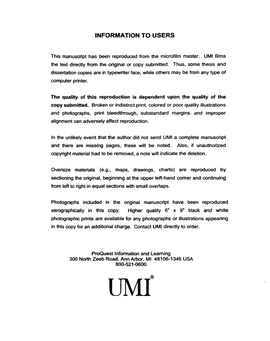| dc.contributor.advisor | Fink, L. Dee, | en_US |
| dc.contributor.advisor | Kolar, Randall L., | en_US |
| dc.contributor.author | Wolfe, Vickie Lynn. | en_US |
| dc.date.accessioned | 2013-08-16T12:18:31Z | |
| dc.date.available | 2013-08-16T12:18:31Z | |
| dc.date.issued | 2002 | en_US |
| dc.identifier.uri | https://hdl.handle.net/11244/443 | |
| dc.description.abstract | In order to examine the extent to which four-year institutions in the U.S. provide for the environmental education of students in nonenvironmental majors, and to identify various approaches to increasing environmental literacy at the college level, chief academic officers at these institutions were surveyed electronically. Of the 496 responding institutions (representing a 42.3 percent response rate), 11.6 percent indicated that an "environmental literacy" course was required of all students, and 55.0 percent reported that such a course was available and countable toward the institution's general education requirements. At least one "environmental" minor (e.g. Environmental Science, Environmental Studies) was offered at 33.7 percent of the institutions. Thirty-nine percent reported the existence of an "environmental" academic program that offered a course appropriate for non-majors. | en_US |
| dc.description.abstract | Various approaches to achieving environmental literacy at the college level are discussed, as are statistical differences in survey responses (1) among Carnegie classifications, from Research to Baccalaureate; (2) between public and private institutions; and (3) among geographical regions. Generally, proportions of positive responses were greater among Research institutions than among the other Carnegie categories, and among public than private institutions. | en_US |
| dc.description.abstract | Also explored are ways in which higher education institutions can enhance environmental education at the K--12 level, as well as some of the obstacles to such efforts. Brief overviews are provided of several higher education institutions' activities in the area of K--12 environmental education, either in the form of direct outreach to K--12 students, teacher training (pre-service or in-service), or both. Methods used by some of the programs to assess their success are discussed briefly, as are impediments to higher education institutions' enhancement of K--12 environmental education. Prominent among these impediments are funding and the traditional higher education faculty rewards system. Factors relevant to the latter are addressed; they include the extent to which the institution's mission recognizes a commitment to collaboration with the public schools; the recency of the institution's emphasis on K--12 collaboration; the institution's organizational and governance structure; and the size of the institution. | en_US |
| dc.format.extent | xii, 307 leaves : | en_US |
| dc.subject | Education, Higher Research. | en_US |
| dc.subject | Education, Elementary. | en_US |
| dc.subject | Education, Elementary Research. | en_US |
| dc.subject | Education, Higher. | en_US |
| dc.subject | Education, Curriculum and Instruction. | en_US |
| dc.subject | Environmental education. | en_US |
| dc.subject | Education, Sciences. | en_US |
| dc.title | Studies of the content and process of environmental education. | en_US |
| dc.type | Thesis | en_US |
| dc.thesis.degree | Ph.D. | en_US |
| dc.thesis.degreeDiscipline | School of Civil Engineering and Environmental Science | en_US |
| dc.note | Major Professors: Randall L. Kolar; L. Dee Fink. | en_US |
| dc.note | Source: Dissertation Abstracts International, Volume: 63-02, Section: A, page: 0491. | en_US |
| ou.identifier | (UMI)AAI3042512 | en_US |
| ou.group | College of Engineering::School of Civil Engineering and Environmental Science | |
